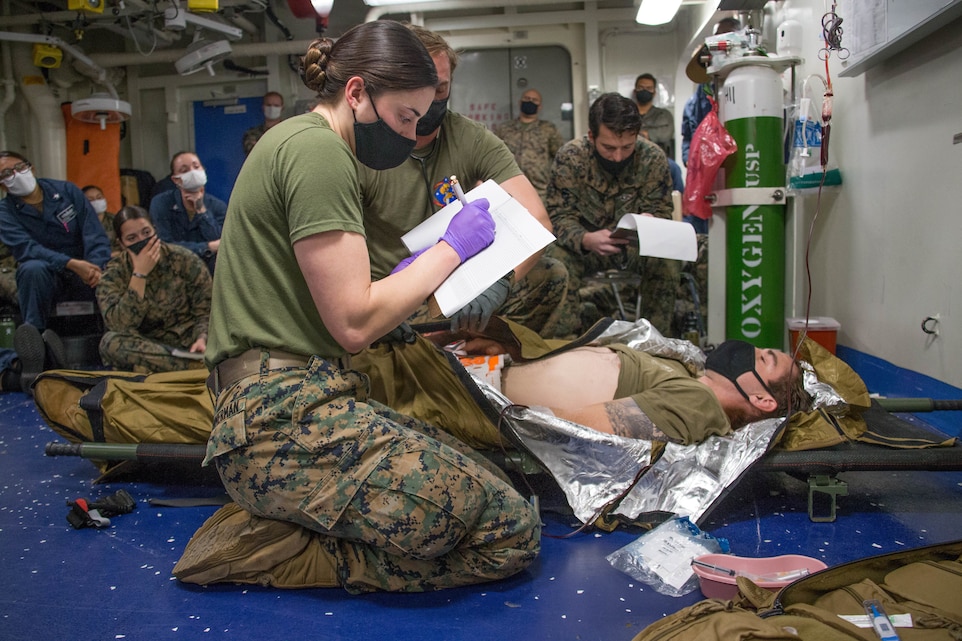
While on a mission in a hostile environment, a U.S. Marine sustains a gunshot wound which strikes an artery, immediately causing decreased blood circulation and oxygenation throughout the body. In addition to the Marine’s excessive bleeding, the Marine is showing signs of pale skin, a racing heart and low blood pressure from the injury.
After suppressing incoming enemy fire, his fellow Marine races to his side to apply pressure to the wound until the platoon corpsman arrives. After seeing the wounded Marine’s condition and considering the excessive amount of blood loss, the corpsman assesses that the injured Marine requires an on scene blood transfusion.
Recently, the U.S. Navy adopted emergency fresh whole blood transfusions on the battlefield, known as ‘Valkyrie,’ from U.S. Army special operation’s Ranger O Low Titer Whole Blood Program – to help sustain the lives of troops on the ground.
“The Valkyrie program was created to introduce blood transfusions to general corpsmen,” said U.S. Navy Hospital Corpsman 3rd Class Ember Zimmerman with Weapons Company, Battalion Landing Team 1/4, 15th Marine Expeditionary Unit. “So far, it has been quite a success with trying to get people familiarized with it, creating instructors and bringing it back into medicine.”
U.S. Navy Lt. Cmdr. Russell Wier, a deputy division surgeon assigned to 1st Marine Division, developed the program in 2017 for corpsmen to use as general practice of field medicine.
“Instructing will increase our overall ability to save lives in any environment.” U.S. Navy Hospital Corpsman 3rd Class Ember Zimmerman, 15th MEU hospital corpsman
The 15th MEU set sail for their Western Pacific 20-1 deployment in November, embarking aboard the Makin Island Amphibious Ready Group, composed of the amphibious assault ship USS Makin Island (LHD 8), the amphibious transport dock ship USS San Diego (LPD 22) and the amphibious transport dock ship USS Somerset (LPD 25). This deployment marks the first time the 15th MEU has provided Valkyrie program training.
During the five-day course of the program, corpsmen train with volunteer blood donors. They draw blood into a donor bag, and transfuse the blood right back into the volunteer. This process takes 10 to 15 minutes. According to Zimmerman, in a real-life event, a Marine assisting would draw the blood and the corpsman would administer the blood drawn to the patient in critical condition.
Blood drawn on scene is also known as pre-hospital blood. Service members injured in combat wait an average of 36 minutes for casualty evacuation aircraft. The medical care provided between the time of injury and casualty evacuation, including pre-hospital blood transfusions when required, significantly reduces the mortality rates according to research cited in the Joint Trauma System Clinical Practice Guideline on Damage Control Resuscitation.
“There have been studies shown that those who have not received pre-hospital blood within the 36 minutes have a higher mortality rate,” said U.S. Navy Hospital Corpsman 2nd Class Steven Hill with Combat Logistics Battalion 15, 15th MEU.
A primary advantage to fresh whole blood transfusion is that no storage or refrigeration is required.
“Pre-drawn or stored whole blood is another great option for pushing blood far forward to the corpsman and Marines at the point-of-injury, but does have some potential side effects associated with temperature and storage lesions,” said U.S. Navy Lt. Cmdr. Michael Hight, medical surgeon with the 15th MEU. “You need to give make sure the pre-drawn or stored whole blood can be given back warmed up. Whereas, fresh whole blood is already in our bodies at 98.6 degrees and when we give it to someone else, it’s already warmed for them.”
According to the Red Blood Cross website, only seven percent of the population have O negative blood, the universal donor blood type. Marines with O negative blood type who volunteer are tested and included on a donor roster, making it easy for corpsmen to identify potential donors before heading out to execute a mission.
“We started the volunteer donor process in June, when we had dozens of Marines and Sailors come to the blood bus,” said Hight. “Pre mission, they will do a series of blood tests where they will be tested for type, low titer status and transmissible transfusion related diseases.”
Since the first Valkyrie program training in 2018, over 230 corpsmen throughout the Navy have been trained and certified to perform blood transfusions. Since April 2020, over 100 Marines throughout the Marine Corps have received the training, as well. As of January 2021, 35 corpsmen and 20 Marines of the 15th MEU have received the training.
Medical personnel with the 15th MEU have a goal to instruct and train as many Sailors and Marines as possible while deployed aboard ship.
“Instructing will increase our overall ability to save lives in any environment,” said Zimmerman. “It is the most ideal way to treat a massive hemorrhage, and the more people who are familiar with the training, the more lives we can save.”
February 02, 2021 at 09:10PM
https://www.marines.mil/News/News-Display/Article/2489777/valkyrie-emergency-fresh-whole-blood-transfusion-enhances-15th-meu-medical-capa/
Valkyrie: emergency fresh whole blood transfusion enhances 15th MEU medical capabilities - Marines.mil
https://news.google.com/search?q=fresh&hl=en-US&gl=US&ceid=US:en

No comments:
Post a Comment